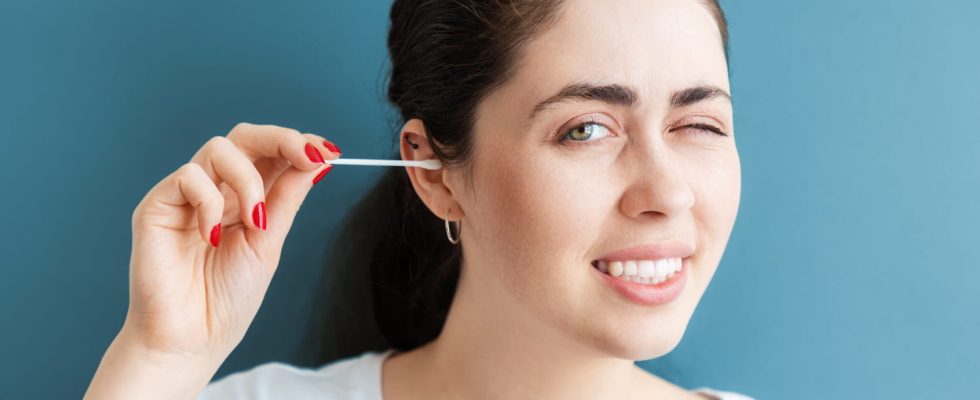Earwax (or earwax) blockage is common and can result from overuse of cotton swabs. How to remove it? When to consult an ENT? Photo, symptoms, solutions…
It is commonly called “the earwax plug”. Earwax is an accumulation of greasy, yellowish “wax” which can clog the ear and promote infections. “It’s exactly as if you were wearing a earplug“, sums up Dr. Nils Morel, otolaryngologist and President of the National Syndicate of Doctors Specialized in ENT and Cervicofacial Surgery, whom we interviewed. What are the symptoms of a plug in the ear? Can he go alone? If not, how to remove it? Naturally?
What is an earwax plug?
Earwax is a fatty, waxy-looking and yellowish-colored material that is found in the ears. “It has a protective role for the ear. Its greasy and waxy nature protects the ear from water, traps dust and other foreign bodies”, specifies Dr. Nils Morel from the outset. By lubricating the eardrum, earwax allows it to protect itself against external aggressions and to ensure its sound transmission function. It is made up of secretions from the sebaceous and ceruminous glands, dead skin cells and dust. Earwax flows out of the ear canal in a natural way but when it is too thickit accumulates and eventually forms what is called a plug.
What are the symptoms of an earwax plug?
Symptoms caused by an earwax plug are:
- A clogged or cottony feeling in the ears
- buzzing
- tinnitus
- Sometimes hearing loss (moderate and gradual)
These symptoms are not always specific to an earwax plug and can also evoke an otitis. You should seek advice from your doctor.
What are the causes of an earwax plug?
► Humidity, swimming: “In the summer, earwax can swell with humidity, which causes the ear to clog and can promote infection”explains Dr. Nils Morel.
► The quality of earwax Who can influence the formation of clogs. “It differs from one individual to another. Some have very dry earwax, others muddy”, specifies the ENT.
► The presence of ear eczema can also change the appearance of earwax and lead to plugs.
► An anomaly of the auditory canal (external otitis, presence of hair in the canal, etc.)
► Repeated cleaning of the ear canal with cotton swabs stimulates the production of earwax, and compacts it in the bottom of the auditory canal.
► Clean the ear canal: “In the vast majority of people, earwax is not a problem and cleaning the entrance to the ear canal can be done at most once a week, using a cotton swab or a small curette.
► Consult an ENT. People who are unlucky enough to have a non-self-cleaning ear canal will need to see their doctor for help in removing earwax buildup. The situations can be very varied and there is no universal recommended method”, notes Dr. Morel. To remove the cork, the ENT doctor can use:
- A mini vacuum cleaner
- pliers
- hooks
- Of curettes
- From a view under a microscope
- Ceruminolytics (Cerulyse®, Doculyse®, etc.)
- Duct irrigation washes
“In prevention, it will sometimes be necessary to prevent water from entering the ear, earwax from being packed down by earphones/noise plugs/cotton swabs… For the rest, it’s a question of the shape of the ear and earwax quality: some people have a “perfect” ear canal, others have a shape that leads to the accumulation of earwax”, explains Dr. Morel. And hard to do anything about it!
Let’s remember the instructions for using the cotton swab: “It is not made to go inside the duct, but to clean the edges, remove what you see. Otherwise, you risk causing irritation or even damage to the eardrum”, he warns.
Thank you to Doctor Nils Morel, otolaryngologist and President of the National Union of ENT and Cervicofacial Surgery (SNORL).
